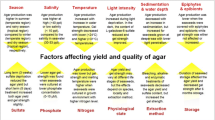Abstract
The red seaweeds Gelidiella acerosa and Gracilaria mammillaris growing along the coast of Venezuela were investigated as potential economic sources of agar. Agar extracted from Gracilaria mammillaris accounted for 27% of the algal dry weight but had quite a poor gelling ability because of the presence of alkali-stable sulphate groups on the D-galactose residue. However, the gel strength of its aqueous solutions was considerably enhanced by the addition of potassium, sodium and calcium ions (up to 1N). On the contrary, the galactan from Gelidiella acerosa (yield of about 20% w/w) exhibited quite good properties. In particular, the gel strength was comparable to that of commercial agaroses. Sulphate esters were not detectable by chemical methods and NMR spectroscopy revealed an agarose backbone with a high degree of methylation on both D and L-galactose residues.
Similar content being viewed by others
References
Armisen, R. & F. Galatas, 1987. Production, properties and uses of agar. In D.J. McHugh (ed.), Production and utilisation of products from commercial seaweeds. FAO Fish. Tech. Pap. 288: 1–57.
Craigie, J. S., 1990. Cell walls. In K. M. Cole & R. G. Sheath (eds), Biology of the red algae, Cambridge University Press, Cambridge: 221–257.
Craigie, J. S. & C. Leigh, 1978. Carrageenans and agars. In J. A. Hellebust & J. S. Craigie (eds), Handbook of phycological methods. Physiological and biochemical methods. Cambridge University Press, Cambridge: 109–131.
Critchley, A. T., 1993. Gracilaria Gracilariales Rhodophyta: an economically important agarophyte. In M. Ohno & A. T. Critchely (eds), Seaweed cultivation and marine ranching, Japan International Cooperation Agency, Yokosuka: 89–112.
Lahaye, M. & W. Yaphe, 1988. Effects of seasons on the chemical structure and gel strength of Gracilaria pseudoverrucosa agar (Gracilariaceae, Rhodophyta). Carbohydr. Polym. 8: 285–301.
Lahaye, M., C. Rochas & W. Yaphe, 1986. A new procedure for determining the heterogeneity of agar polymers in the cell walls of Gracilaria spp. (Gracilariaceae, Rhodophyta). Can. J. Bot. 64: 579–585.
Lahaye, M., W. Yaphe & C. Rochas, 1985. 13C-NMR analysis of sulphated and desulphated agar type polysaccharides. Carbohydr. Res. 143: 240–245.
Lemus, A., K. Bird, D. F. Kapraun & F. Khoen, 1991. Agar yield, quality and standing crop biomass of Gelidium serrulatum, Gelidium floridanum and Pterocladia capillacea in Venezuela. Food Hydrocolloids 5: 469–479.
Martinsen, A., G. Skjåk-Bræk, O. Smidsrød, F. Zanetti & S. Paoletti, 1991. Comparison of different methods for determination of molecular weight and molecular weight distribution of alginates. Carbohydr. Polym. 15: 171–193.
Murano, E., 1995. Chemical structure and quality of agars from Gracilaria. J. appl. Phycol. 7: 245–254.
Murano, E., R. Toffanin, S. H. Knutsen, B. Focher, R. Rizzo & S. Paoletti S, 1993. Evaluation of steam explosion as pretreatment in agar extraction from Gracilaria dura (C. Agardh) J. Agardh (Gracilariaceae, Rhodophyta). J. appl. Phycol. 5: 417–424.
Murano, E., R. Toffanin, F. Zanetti, S. H. Knutsen, S. Paoletti & R. Rizzo, 1992. Chemical and macromolecular characterisation of agars polymers from Gracilaria dura (C. Agardh) J. Agardh (Gracilariaceae, Rhodophyta). Carbohydr. Polym. 18: 171–178.
Nicolaisen, F. M., I. Meyland & K. Schaumburg, 1980. 13C-NMR spectra at 67.9 MHz of agarose solutions and partly 6-O-methylated agarose at 95 °C. Acta chem. scand. Ser. B 34: 103–107.
Painter, T. J., 1983. Algal polysaccharides. In G. O. Aspinall (ed.), The Polysaccharides, Vol. 2. Academic Press, New York: 195–285.
Rincones, R. E., 1994. Phycological research in Venezuela. Applied Phycology Forum 11: 10–12.
Santos, G. A. & M. S. Doty, 1983. Agar from some Hawaiian red algae. Aquat. Bot. 16: 385–389.
Shashkov, A. S., A. I. Usov & S. V. Yarotsky, 1978. Polysaccharides of algae. XXIV The application of 13C-NMR spectroscopy to the analysis of the structures of polysaccharides of the agar group. Bioorg. Khim. 4: 74–81.
Terho, T. T. & K. Hartiala, 1971. Method for the determination of the sulphate content of glycosaminoglycans. Analyt. Biochem. 41: 471–476.
Usov, A. I., E. G. Ivanova & A. S. Shashkov, 1983. Polysaccharides of algae XXXIII: Isolation and 13C-NMR spectral study of some new gel-forming polysaccharides from Japan sea red seaweeds. Bot. mar. 26: 285–294.
Usov, A. I., S. V. Yarostky & A. S. Shashkov, 1980. 13C-NMR spectroscopy of red algal galactans. Biopolymers 19: 977–990.
Valiente, O., L. E. Fernandez, R. M. Perez, G. Marquina & H. Velez, 1992. Agar polysaccharides from the red seaweeds Gracilaria domingensis Sonder ex Kützing and Gracilaria mammillaris (Montagne) Howe. Bot. mar. 35: 77–81.
Author information
Authors and Affiliations
Rights and permissions
About this article
Cite this article
Murano, E., Toffanin, R., Pedersini, C. et al. Structure and properties of agar from two unexploited agarophytes from Venezuela. Hydrobiologia 326, 497–500 (1996). https://doi.org/10.1007/BF00047851
Issue Date:
DOI: https://doi.org/10.1007/BF00047851




